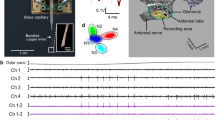Summary
In recordings of single unit action potentials, the responses of CO2-receptors in the labial palp organ of the moth Heliothis armigera to modulation of CO2-density around a background of 350 ppm were investigated. Modulation of CO2-density by square wave changes in concentration at constant barometric pressure evokes modulation of the spike rate. Modulation of CO2-density by square wave changes in barometric pressure at constant CO2-concentration evokes responses similar to those evoked by concentration modulation. For modulation depths of less than 1.5%, the output modulation depth is linearly related to the input; at higher modulation depths the gain decreases progressively.
Using sinusoidal pressure modulation, the frequency dependence of both gain and output noise was determined over a range of 0.05 to 12.8 Hz. With increasing frequency the gain progressively increases at a rate of 2.4 dB/octave up to a maximum of 63 at 3 Hz; at higher frequencies, it decreases rapidly. The threshold sensitivity of the receptors, using input noise amplitude density as a criterion, is broadly tuned, with a minimum of 1 % contrast Hz-0.5 between 0.3 and 3 Hz. Using these figures, it is concluded that the sensory organ is capable of detecting fluctuations in CO2-density of 0.14% or 0.5 ppm. The results are related to the fluctuations in CO2-density which occur in a natural environment.
Similar content being viewed by others
References
Anderson JR, Olkowski W (1968) Carbon dioxide as an attractant for host-seeking Cephenemyia females (Diptera:Oestridae). Nature 220:190–191
Bogner F (1990) Sensory physiological investigation of carbon dioxide receptors in Lepidoptera. J Insect Physiol 36:951–957
Bogner F, Boppré M, Ernst K-D, Boeckh J (1986) CO2-sensitive receptors on labial palps of Rhodogastria moths (Lepidoptera: Arctiidae): physiology, fine structure and projection. J Comp Physiol A 158:741–749
Burkhardt JF (1991) The influence of different CO2-concentrations on the behaviour of the ant, Pheidole pallidula. Verh Dtsch Zool Ges 84:303–304
Denmead OT, Bradley EF (1987) On scalar transport in plant canopies. Irrig Sci 8:131–149
Desjardines RL, Brach EJ, Alvo P, Schuepp PH (1982) Aircraft monitoring of surface carbon dioxide exchange. Science 216:733–735
Desjardines RL, Macpherson JI, Schuepp PH, Karanja F (1989) An evaluation of aircraft flux measurements of CO2, water vapor and sensible heat. Boundary-Layer Meteorology 47:55–69
Drake VA, Farrow RA (1988) The influence of atmospheric structure and motions on insect migration. Annu Rev Entomol 33:183–210
French AS (1980) Sensory transduction in an insect mechanoreceptor: linear and nonlinear properties. Biol Cybern 38:115–123
Gillies MT (1980) The role of carbon dioxide in host-finding by mosquitoes (Diptera: Culicidae): a review. Bull Entomol Res 70:525–532
Goldberg JM, Brown PB (1969) Response of binaural neurons of dog superior olivary complex to dichotic tonal stimuli: some physiological mechanisms of sound localization. J Neurophysiol 32:613–636
Holscher KH, Gearhart HL, Barker RW (1980) Electrophysiological responses of three tick species to carbon dioxide in the laboratory and field. Ann Entomol Soc Am 73:288–292
Kaib M (1991) Chemical signals of a termite: behavioural and adaptive significance. Verh Dtsch Zool Ges 84:312–313
Kaissling KE, Kramer E (1990) Sensory basis of pheromonemediated orientation in moths. Verh Dtsch Zool Ges 83:109–131
Kellog FE (1970) Water vapour and carbon dioxide receptors in Aedes aegypti. J Insect Physiol 16:99–108
Kent KS, Harrow ID, Quartararo P, Hildebrand JG (1986) An accessory olfactory pathway in Lepidoptera: the labial pit organ and its central projections in Manduca sexta and certain other sphinx moths and silk moths. Cell Tissue Res 245:237–245
Klingler J (1957) Über die Bedeutung des Kohlendioxydes für die Orientierung der Larven von Otiorrhynchus sulcatus F., Melolontha und Agriotes (Col.) im Boden. Mitt Schweiz Entomol Ges 30:317–322
Kramer E (1986) Turbulent diffusion and pheromone-triggered anemotaxis. In: Payne TL, Birch MC, Kennedy CEJ (eds) Mechanisms in insect olfaction. Clarendon Press, Oxford, pp 11–25
Lacher V (1964) Elektrophysiologische Untersuchungen an einzelnen Rezeptoren für Geruch, Kohlendioxyd, Luftfeuchtigkeit und Temperatur auf den Antennen der Arbeitsbiene und Drohne (Apis mellifera L.). Z Vergl Physiol 48:587–623
Lee J-K, Selzer R, Altner H (1985) Lamellated outer dendritic segments of a chemoreceptor within wall-pore sensilla in the labial palp-pit organ of the butterfly (Pieris rapae L. Insecta, Lepidoptera). Cell Tissue Res 240:333–342
Lüscher M (1961) Air conditioned termite nests. Sci Am 205/1:138–145
Malmstadt HV, Enke G, Crouch SR, Horlick G (1974) Optimization of electronic measurements. Instrumentation for Scientists series, module 4. Benjamin-Cummings, Menlo Park
Murlis J, Jones CD (1981) Fine-scale structure of odour plumes in relation to insect orientation to distant pheromone and other attractant sources. Physiol Entomology 6:71–86
Reichardt W, Varjú D (1959) Übertragungseigenschaften im Auswertesystem für das Bewegungssehen. Z Naturforsch 14b:674–689
Seeley TD (1974) Atmospheric carbon dioxide regulation in honeybee colonies. J Insect Physiol 20:2301–2305
Stange G (1975) Linear relation between stimulus concentration and primary transduction process in insect CO2-receptors. In: Denton DA, Coghlan JP (eds) Olfaction and taste V. Academic Press, New York, pp 207–211
Thorson J (1966) Small signal analysis of a visual reflex in the locust. II. Frequency dependence. Kybernetik 3:53–66
Thorson J, Biedermann-Thorson M (1974) Distributed relaxation processes in sensory adaptation. Science 183:161–172
Yamana K, Toh Y, Tateda H (1986) Electrophysiological studies on the temporal organ of the Japanese house centipede, Thereuonema hilgendorfi. J Exp Biol 126:297–314
Author information
Authors and Affiliations
Rights and permissions
About this article
Cite this article
Stange, G. High resolution measurement of atmospheric carbon dioxide concentration changes by the labial palp organ of the moth Heliothis armigera (Lepidoptera: Noctuidae). J Comp Physiol A 171, 317–324 (1992). https://doi.org/10.1007/BF00223962
Accepted:
Issue Date:
DOI: https://doi.org/10.1007/BF00223962




